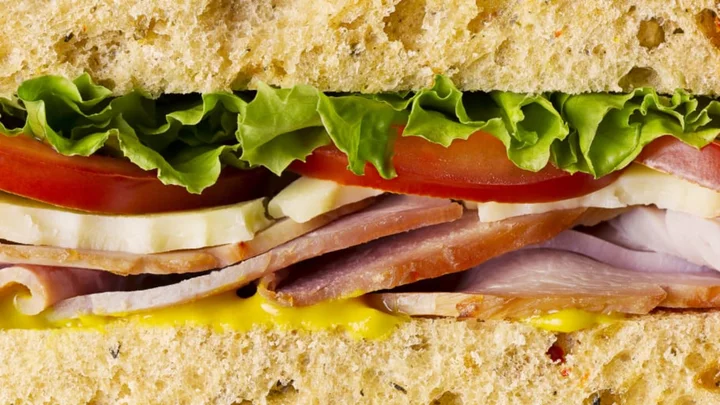It’s easy to say what a sandwich is. Grilled cheese? Definitely a sandwich. Bacon, lettuce, and tomato? There’s no question. Things start to get messy when you specify what a sandwich isn’t. Is a hot dog a sandwich? What about a burrito, or an open-faced turkey melt?
The question of sandwich-hood sounds like something a monk might ponder on a mountaintop. But the answer has real-world implications: On several occasions, governments have ruled on the food industry’s right to use the delectable label; even the late Ruth Bader Ginsburg weighed in on the matter.
When pressed on the hot-button issue as to whether a hot dog is a sandwich while appearing on The Late Show with Stephen Colbert in 2018, Ginsburg proved her extreme judiciousness by throwing the question back at Colbert and asking for his definition of sandwich before making a ruling. Her summation? A hot dog fits Colbert’s definition of a sandwich, and therefore can be considered one.
Merriam-Webster even joined the debate by boldly declaring that a hot dog is a sandwich back in 2016 (even if the Hot Dog Council disagrees). Officially, here’s where the law stands on the great sandwich debate.
1. California: Hot Dogs Are Sandwiches
Hot dogs are often snagged in the center of the sandwich semantics drama. Despite fitting the description of a food product served on a bread-like product, many sandwich purists insist that hot dogs deserve their own category. California joins Merriam-Webster in declaring that a hot dog is a sandwich, nonetheless. The bold word choice appears in the state’s tax law, which mentions “hot dog and hamburger sandwiches” served from “sandwich stands or booths.” Applying the sandwich label to burgers is less controversial, but it’s still worth debating.
2. Massachusetts Court: A Burrito Is Not a Sandwich
When Qdoba threatened to encroach on the territory of a Panera Bread in Shrewsbury, Massachusetts, the owners of the bakery franchise fought back. They claimed the Mexican chain’s arrival would violate their lease agreement with the White City Shopping Center—specifically the clause that prohibits the strip mall from renting to other sandwich restaurants. “We were surprised at the suit because we think it’s common sense that a burrito is not a sandwich,” Jeff Ackerman, owner of the Qdoba franchise group, told The Boston Globe.
The Worcester County Superior Court agreed. When the issue went before the court in 2006, Cambridge chef and food writer Christopher Schlesinger testified against Panera [PDF], saying, “I know of no chef or culinary historian who would call a burrito a sandwich. Indeed, the notion would be absurd to any credible chef or culinary historian.”
Justice Jeffrey A. Locke ruled that Qdoba would be allowed to move into the shopping center citing an entry in Merriam-Webster as the most damning evidence against Panera’s case. “The New Webster Third International Dictionary describes a ‘sandwich’ as ‘two thin pieces of bread, usually buttered, with a thin layer (as of meat, cheese, or savory mixture) spread between them,’” he said. “Under this definition and as dictated by common sense, this court finds that the term ‘sandwich’ is not commonly understood to include burritos, tacos, and quesadillas.”
3. USDA: A Sandwich Is Meat Between Two Slices of Bread
If you want to know the definition of a certain dish, the officials at the U.S. Department of Agriculture are good people to ask. It’s their job to make sure that the nation’s supply of meat is correctly labeled. When it comes to sandwiches, the agency follows strict criteria. “A sandwich is a meat or poultry filling between two slices of bread, a bun, or a biscuit,” Mark Wheeler, who works in food and safety at the USDA, told NPR. His definition comes from the Food Standards and Labeling Policy Book used by the department (the USDA only covers the “labeling of meat, poultry, and egg products,” while the FDA handles everything else, which is why the USDA’s definition excludes things like grilled cheese). Not included under their umbrella of foodstuff served between bread are burritos, wraps, and hot dogs.
4. Also the USDA: A Burrito Is a “Sandwich-Like Product”
The USDA’s definition may not be as simple and elegant as it seems. A sandwich is one thing, but a “sandwich-like product” is different territory. The same labeling policy book Mark Wheeler referred to when describing a sandwich lumps burritos into this vague category. Fajitas “may also be” a sandwich-like product, as long as the strips of meat in question come bundled in a tortilla. Another section of the book lists hot dogs and hamburgers as examples of sandwich-type products when laying out inspection policies for pre-packaged dinners. So is there an example of a meat-wrapped-in-carb dish that doesn’t belong to the sandwich family? Apparently, strombolis are where the USDA draws the line. The Food Standards and Labeling Policy Book clearly states the product “is not considered a traditional sandwich” [PDF].
5. New York: If It’s Served on Something Remotely Bread-Like, It’s a Sandwich
When it comes to sandwiches, New York doesn’t discriminate. In a bulletin outlining the state’s tax policy, a description of what constitutes a sandwich warrants its own subhead. The article reads:
“Sandwiches include cold and hot sandwiches of every kind that are prepared and ready to be eaten, whether made on bread, on bagels, on rolls, in pitas, in wraps, or otherwise, and regardless of the filling or number of layers. A sandwich can be as simple as a buttered bagel or roll, or as elaborate as a six-foot, toasted submarine sandwich.”
It then moves on to examples of taxable sandwiches. The list includes items widely believed to bear the label, like Reubens, paninis, club sandwiches, and peanut butter and jelly sandwiches. Other entries, like burritos, gyros, open-faced sandwiches, and hot dogs, may cause confusion among diners.
A version of this story originally ran in 2018; it has been updated for 2023.
This article was originally published on www.mentalfloss.com as 5 Ways to Define a Sandwich, According to the Law.









